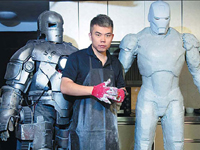Father of Chinese stenography dies
Tang Yawei started exploring the possibility of a shorthand machine as early as the "cultural revolution" (1966-76), and he invented a set of symbols based on the keyboard of English typewriter at that time. It failed due to its complicated rules and noise.
"Pen stenography is convenient as one can take notes as long as one has pen and paper. But it is tedious to translate these symbols into words. It may take six hours to translate an hour's steno note," he said.
In the 1990s, inspired by a piano performance, Tang designed an exclusive keyboard that allows stenographers to press the keys with both hands at the same time, one for initial consonants and another for compound vowels.
The new steno keyboard saves a lot of time compared with traditional typing.
He believed shorthand could be greatly developed if a computer could do the boring translation work instead. Tang, in his 70s, redesigned a 24-key shorthand keyboard and steno-coding scheme for the computer in 1993 after many experiments and failures.
One year later, Yawei Steno Machine made its debut at the National Computer Exhibition, attracting wide attention, and many Chinese courts started to use it in 1996.
He became interested in stenography by accident in 1930, when he was attracted to Gregg Shorthand in a second-hand bookstore. The book introduced English stenography that gained popularity in the US in the early 20th century. As he found the subject very useful, he started to read related books.
Later while he was studying in a mission school and served as secretary to the headmaster, he developed the popular Yawei shorthand method through his daily work of recording documents and letters.
After the outbreak of the War of Resistance Against Japanese Aggression in 1937, Tang escaped to Chongqing and taught shorthand as a means of livelihood for many jobless youth.
Financially supported by his mother and friends, he published the book Standard Yawei Chinese Shorthand and offered stenography training.
Later, he founded Yawei Steno School and met with the patriotic warlord Feng Yuxiang, who greatly supported his work and held the post of board chairman of the school.
When the war ended in 1945, he followed Feng to Shanghai the next year and moved the school there.
Some of his students played important roles in the war. For example, one was spying for the Communist Party and gathering important military intelligence.
"I was shocked as well as sad when I heard about the news. Tang made a great contribution to Chinese stenography," says Lian Zhengbao, former chief archivist of the Bureau of Archives, Ministry of Foreign Affairs.
Lian says he used the Yawei shorthand method at diplomatic occasions with Chinese leaders, including Mao Zedong and Zhou Enlai, from late 1960s to the 1980s.
"It's both quick and accurate," he says.
xulin@chinadaily.com.cn




















